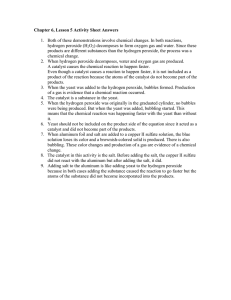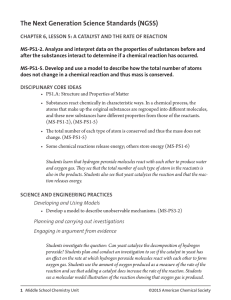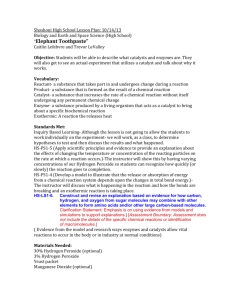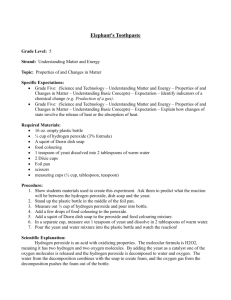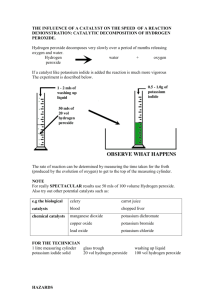Activity Sheet Name ___________________ Chapter 6, Lesson 5
advertisement
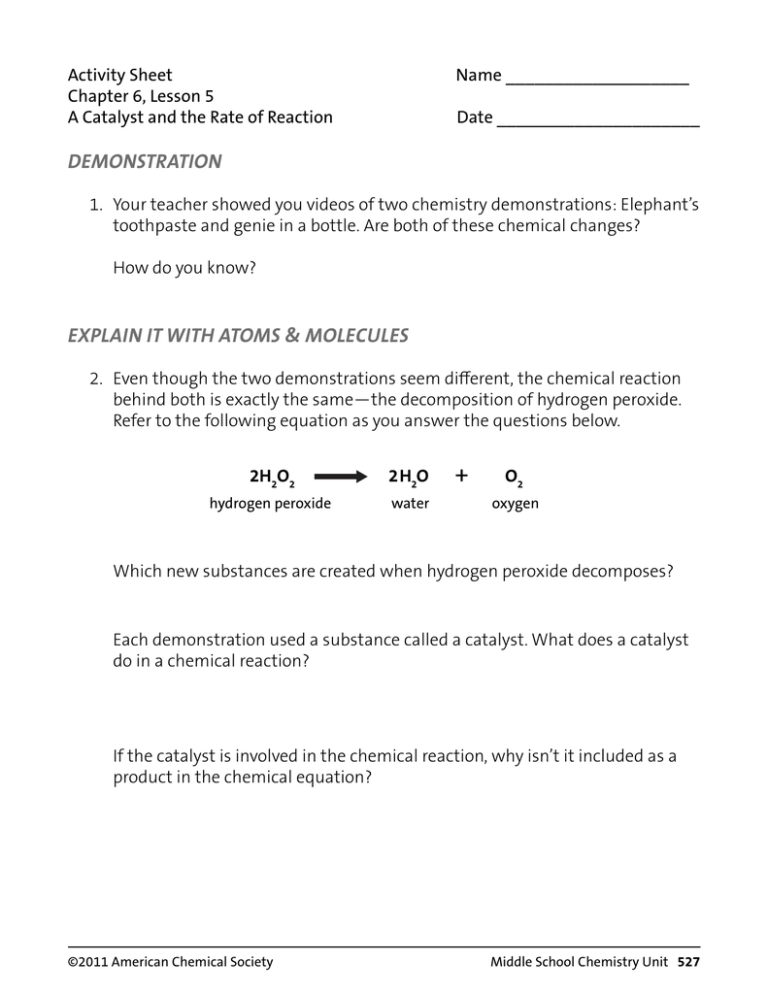
Activity Sheet Chapter 6, Lesson 5 A Catalyst and the Rate of Reaction Name ___________________ Date _____________________ DEMONSTRATION 1. Your teacher showed you videos of two chemistry demonstrations: Elephant’s toothpaste and genie in a bottle. Are both of these chemical changes? How do you know? EXPLAIN IT WITH ATOMS & MOLECULES 2. Even though the two demonstrations seem different, the chemical reaction behind both is exactly the same—the decomposition of hydrogen peroxide. Refer to the following equation as you answer the questions below. 2H2O2 2H2O hydrogen peroxide water + O2 oxygen Which new substances are created when hydrogen peroxide decomposes? Each demonstration used a substance called a catalyst. What does a catalyst do in a chemical reaction? If the catalyst is involved in the chemical reaction, why isn’t it included as a product in the chemical equation? ©2011 American Chemical Society Middle School Chemistry Unit 527 ACTIVITY Question to Investigate Can another substance catalyze the decomposition of hydrogen peroxide? Materials for Each Group • Graduated cylinder • Hydrogen peroxide (3%) • Yeast • Popsicle stick • Detergent solution • Dropper Procedure 1. Add 10 mL of hydrogen peroxide to a graduated cylinder. Add 1 drop of detergent solution. Swirl gently and watch the solution for any bubbling. 2. Use the end of a Popsicle stick to add a small amount of yeast to the hydrogen peroxide in the graduated cylinder and swirl. 3. Place the graduated cylinder on the table and watch for any bubbling. 4. Hold the graduated cylinder to see if there seems to be any change in temperature. 3. What clues did you have that a chemical reaction occurred in this activity? 4. What is the catalyst in this activity? 528 Middle School Chemistry Unit ©2011 American Chemical Society 5. What evidence do you have that hydrogen peroxide decomposed faster when you added yeast? 6. When writing the chemical equation for this reaction, should yeast be included on the product side of the chemical equation? TAKE IT FURTHER Question to Investigate What is the catalyst in the following activity? Materials for Each Group • Copper II sulfate solution (in cup) • Clear plastic cup (empty) • Salt • Piece of aluminum foil • Thermometer • Popsicle stick Procedure 1. Place the piece of aluminum foil in an empty cup. Use your fingers or a popsicle stick to push the foil firmly down so that it lays flat and covers the bottom of the cup. 2. Add all of the copper II sulfate solution to the cup with the aluminum foil. 3. Gently swirl the solution for a few seconds and let it stand still. Watch the aluminum for any bubbling or color change. 4. Use your Popsicle stick to place a small amount of salt in the copper II sulfate solution. Gently swirl the solution for a few seconds and let it stand still. Watch for any bubbling or color change. 5. Carefully place a thermometer in the cup and see if the temperature changes. ©2011 American Chemical Society Middle School Chemistry Unit 529 7. How do you know that a chemical reaction occurs when a piece of aluminum foil and sodium chloride is placed in copper II sulfate solution? 8. What is the catalyst in this activity? 9. How is adding salt to the aluminum similar to adding yeast to the hydrogen peroxide? 530 Middle School Chemistry Unit ©2011 American Chemical Society

